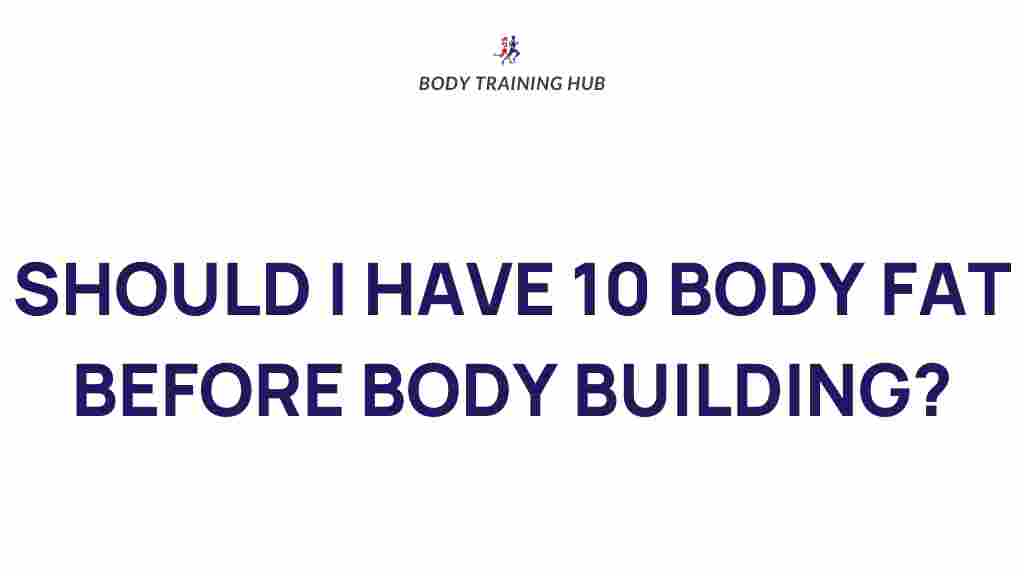Uncovering the Truth: The Impact of Body Fat Percentage on Bodybuilding
Bodybuilding is a complex sport that requires a deep understanding of various factors influencing muscle growth and overall fitness. One of the most debated topics in bodybuilding is the role of body fat percentage. In this article, we will explore the myths and facts surrounding body fat, muscle mass, nutrition, training, and how they all contribute towards achieving your bodybuilding goals.
Understanding Body Fat Percentage
Body fat percentage refers to the proportion of fat in your body compared to lean mass (muscle, bones, organs, etc.). It is a crucial metric for bodybuilders and fitness enthusiasts as it affects overall aesthetics, performance, and health. Understanding your body fat percentage is essential in tailoring your training and nutrition plans to optimize muscle growth while minimizing unnecessary fat gain.
Why Body Fat Matters in Bodybuilding
Maintaining an optimal body fat percentage is vital for several reasons:
- Aesthetics: A lower body fat percentage often leads to a more defined and muscular appearance, which is a primary goal for bodybuilders.
- Performance: Excess body fat can hinder athletic performance, making it harder to achieve strength and endurance goals.
- Health: A healthy body fat percentage contributes to overall well-being and reduces the risk of chronic diseases.
Ideal Body Fat Percentage for Bodybuilders
The ideal body fat percentage varies among individuals, but there are general guidelines that can help:
- Beginners: 15-20% body fat is typical as they build foundational muscle mass.
- Intermediate Lifters: 10-15% body fat is a common range for those with some experience in training.
- Advanced Bodybuilders: 5-10% body fat is often seen in competitive bodybuilders during competition prep.
Remember, these ranges are not absolute, and individual goals will dictate optimal body fat levels.
Training for Muscle Mass while Managing Body Fat
To maximize muscle mass while keeping body fat in check, follow these training principles:
- Strength Training: Focus on compound lifts such as squats, deadlifts, and bench presses. Aim for progressive overload, where you gradually increase the weight or resistance to stimulate muscle growth.
- Cardio: Incorporate cardiovascular exercises to help manage body fat. High-Intensity Interval Training (HIIT) can be particularly effective for fat loss while preserving muscle mass.
- Recovery: Allow adequate time for recovery. Muscle growth occurs during rest, so ensure you have rest days and prioritize sleep.
Nutrition: Fueling Your Body for Success
Nutrition plays a crucial role in bodybuilding and directly impacts body fat percentage. Here are key nutritional strategies:
- Protein Intake: Aim for 1.2 to 2.2 grams of protein per kilogram of body weight to support muscle repair and growth.
- Caloric Surplus/Deficit: Depending on your goals, you may need to eat in a caloric surplus to gain muscle mass or a caloric deficit to lose fat.
- Healthy Fats: Include sources of healthy fats like avocados, nuts, and olive oil. They are essential for hormone production and overall health.
- Carbohydrates: Carbs are vital for energy. Focus on complex carbohydrates such as whole grains, fruits, and vegetables.
For more detailed nutritional guidelines, consult resources like the Academy of Nutrition and Dietetics.
Common Myths About Body Fat and Bodybuilding
There are several myths surrounding body fat and bodybuilding that can mislead individuals:
- Myth 1: “You need to be extremely lean to build muscle.” While lower body fat can enhance aesthetics, building muscle is possible at higher body fat percentages.
- Myth 2: “All fats are bad.” Healthy fats are essential for hormone production and overall health.
- Myth 3: “You can spot reduce fat.” Fat loss occurs uniformly throughout the body, not in specific areas.
Facts About Body Fat and Bodybuilding
It’s crucial to distinguish facts from myths:
- Fact 1: Body fat serves essential functions, including hormone regulation and energy storage.
- Fact 2: Muscle mass is more metabolically active than fat, meaning that increasing muscle can help improve body composition.
- Fact 3: Consistent training and proper nutrition can significantly impact body fat percentage over time.
Setting Realistic Goals
When it comes to bodybuilding, setting realistic goals is paramount. Here’s how to set effective goals related to body fat and muscle mass:
- Assess Your Starting Point: Understand your current body fat percentage and muscle mass.
- Define Your Objectives: Decide if your primary goal is to lose fat, gain muscle, or maintain your current physique.
- Create a Plan: Develop a training and nutrition plan that aligns with your goals.
- Track Your Progress: Regularly measure your body fat and muscle mass to adjust your plan as needed.
Troubleshooting Common Issues
Even with the best plans, you may encounter challenges. Here are some common issues and how to troubleshoot them:
- Plateau in Muscle Gains: If you stop gaining muscle, consider varying your workout routine or increasing your caloric intake.
- Struggling to Lose Fat: Reassess your diet; you may need to adjust your caloric deficit or increase your physical activity.
- Fatigue and Overtraining: Ensure you are allowing enough recovery time and consuming enough nutrients to support your training.
For further guidance on overcoming training plateaus, check out this resource.
Conclusion
Understanding the impact of body fat percentage on bodybuilding is crucial for anyone looking to enhance their physique and performance. By focusing on the right training, nutrition, and debunking common myths, you can effectively manage your body fat while maximizing muscle mass. Remember to set realistic goals and be patient with your progress. Bodybuilding is a marathon, not a sprint, and with the right approach, you can achieve the physique you desire. Stay committed, and embrace the journey of fitness!
This article is in the category Myths & Facts and created by BodyTraining Team

1 thought on “Uncovering the Truth: The Impact of Body Fat Percentage on Bodybuilding”